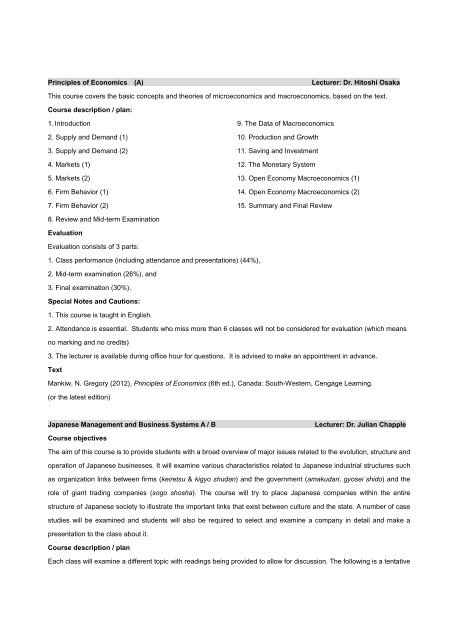GLOBAL JAPAN PROGRAM â Course Outlines (A â Spring ...
GLOBAL JAPAN PROGRAM â Course Outlines (A â Spring ...
GLOBAL JAPAN PROGRAM â Course Outlines (A â Spring ...
You also want an ePaper? Increase the reach of your titles
YUMPU automatically turns print PDFs into web optimized ePapers that Google loves.
Principles of Economics (A) Lecturer: Dr. Hitoshi Osaka<br />
This course covers the basic concepts and theories of microeconomics and macroeconomics, based on the text.<br />
<strong>Course</strong> description / plan:<br />
1. Introduction<br />
2. Supply and Demand (1)<br />
3. Supply and Demand (2)<br />
4. Markets (1)<br />
5. Markets (2)<br />
6. Firm Behavior (1)<br />
7. Firm Behavior (2)<br />
9. The Data of Macroeconomics<br />
10. Production and Growth<br />
11. Saving and Investment<br />
12. The Monetary System<br />
13. Open Economy Macroeconomics (1)<br />
14. Open Economy Macroeconomics (2)<br />
15. Summary and Final Review<br />
8. Review and Mid-term Examination<br />
Evaluation<br />
Evaluation consists of 3 parts:<br />
1. Class performance (including attendance and presentations) (44%),<br />
2. Mid-term examination (26%), and<br />
3. Final examination (30%).<br />
Special Notes and Cautions:<br />
1. This course is taught in English.<br />
2. Attendance is essential. Students who miss more than 6 classes will not be considered for evaluation (which means<br />
no marking and no credits)<br />
3. The lecturer is available during office hour for questions. It is advised to make an appointment in advance.<br />
Text<br />
Mankiw, N. Gregory (2012), Principles of Economics (6th ed.), Canada: South-Western, Cengage Learning.<br />
(or the latest edition)<br />
Japanese Management and Business Systems A / B<br />
Lecturer: Dr. Julian Chapple<br />
<strong>Course</strong> objectives<br />
The aim of this course is to provide students with a broad overview of major issues related to the evolution, structure and<br />
operation of Japanese businesses. It will examine various characteristics related to Japanese industrial structures such<br />
as organization links between firms (keiretsu & kigyo shudan) and the government (amakudari, gyosei shido) and the<br />
role of giant trading companies (sogo shosha). The course will try to place Japanese companies within the entire<br />
structure of Japanese society to illustrate the important links that exist between culture and the state. A number of case<br />
studies will be examined and students will also be required to select and examine a company in detail and make a<br />
presentation to the class about it.<br />
<strong>Course</strong> description / plan<br />
Each class will examine a different topic with readings being provided to allow for discussion. The following is a tentative





![Katalog der Ausstellung [pdf, 5663.6k]](https://img.yumpu.com/47907208/1/184x260/katalog-der-ausstellung-pdf-56636k.jpg?quality=85)




